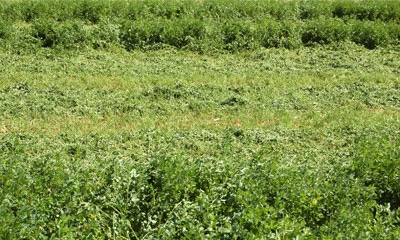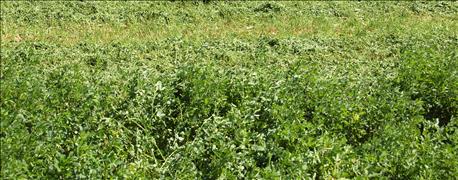June 10, 2016

In this high-tech world, baling hay is still somewhat of an art. There are tools available to help you put some science into the equation, such as moisture probes and thermometers, but baling hay at the right time is still partly feel, luck and skill.
Here are three reasons why it is important to bale hay in that 15% to 20% moisture range. Bad things can happen if the hay is too wet. You can leave leaves and nutrients behind if hay is too dry.
1. Avoid discoloration and molding.

NEEDS TIME TO CURE: The hay cut in the center strips still needs lots of time to cure. Tedding to spread it out might help speed the drying process.
If you bale from 20% to 22% moisture, you may be pushing the envelope. You might risk discoloration of the hay. Hay may begin to pick up a musty odor as well. There may or may not be molding. None of these things are desirable. If hay is just discolored it may not hurt feeding value, but if there is mold and spoilage, it may no longer be suitable to feed to certain types of animals.
2. Minimize risk of barn fires and moldy hay.
Once you get up to 24% to 25% and still bale the hay, you’re moving into a danger zone. At that point, you risk enough heat being generated inside a stack of hay to cause spontaneous combustion. Once a hay fire starts, it is extremely difficult to put out. The result is often a lost barn and ruined hay as well.
The fire itself generally results from excess heating. If you have only a few bales and they are stacked loosely, it might not become an issue. But if you have several hundred bales at excessive moisture stacked together, odds for a barn fire increase.
The heating comes from bacteria working inside the overly damp hay. It’s the bacteria that generate the heat. Nearly all hay goes through a sweat 24 to 48 hours after baling, even if it is baled at the correct moisture content. The temperature may go up slightly. But if the moisture content is too high, the temperature may become hot enough to trigger spontaneous combustion.
Even if that doesn’t happen, the hay may spoil. Mold caused by fungi can also occur with higher moisture content. If you’re feeding beef cattle, it may not be an issue. However, if you’re selling or feeding hay to horse owners or to sheep or dairy producers, moldy hay becomes an issue.
3. Preserve nutrients by not allowing hay to become too dry.
If hay is well below 15%, either because you left it in the field too long or because the crop was well past the proper maturity for cutting in the first place, you may lose valuable nutrients when making and baling hay.
A good share of the nutrients are contained in the leaves, particularly in alfalfa hay, If the hay is too dry when tedded or raked, many leaves may be knocked off and left behind on the ground. That’s why some people prefer raking hay in the morning, when there is still a slight amount of dampness. As noted earlier, getting the right moisture content is still partly an art — not all science.
Parker is a retired Purdue University Extension ag educator. He operates a beef and forage operation in Morgan County.
You May Also Like




